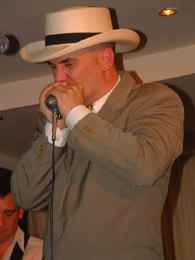Overcoming Beginner’s Twitch
It happens when you first start learning the harmonica. You hit a bum note, so you extend your arms from the elbows to visually locate the right hole on the harmonica, while shaking your head and tutting. By the time you bring the harp back under your nose, the hole’s gone out of focus, you miss your note again, so you tut and extend your arms… That’s beginner’s twitch!
Why do I do it?
Because you’re not keen on playing ‘blind’. That’s perfectly understandable. On every other instrument, you can see what your fingers are doing. On the harmonica your mouth is providing the wind and locating the notes simultaneously. It’s doing what your fingers would otherwise do. That’s just not normal!
What’s the solution?
You haven’t yet developed the navigational systems to locate the right hole without actually seeing it. Think laterally. Ask yourself how you would play the harmonica in the dark?
Firstly, you’d use your ears to determine whether or not you have the correct note (or notes). Get used to listening to yourself. Learn how to correct things audibly. Secondly, while you couldn’t use your fingers, you could use your tongue to locate the right hole. It’s a mouth harmonica after all. Using your tongue is totally legitimate. Get sloppy. You want hole four? Forget the twitch. Count up from hole one with the tip of your tongue. As your skills develop, you’ll learn to use your tongue for note splits, blocking and loads of other fun stuff. Just remember to tap your harp out each time you finish playing!.
Thirdly, by moving the harp and not your head, you’d develop muscle memory in your shoulders, arms, wrists and hands. In time you’ll be able to place the harp in your mouth blindfolded and hit hole four blow every single time. Repetition and patience!
Finally, you’d learn to read the harp. Muscle memory would help, but you could also use the bridges or dividers between the holes as movement indicators. Practice feeling your air flow pass across the bridge from one hole into its neighbours. Play across all the bridges and experiment. Try a controlled trill by playing back and forth across a bridge. All this will help you avoid another beginner’s habit; start-stop-relocate-start-stop-relocate. As Baloo said in Jungle Book, ‘If you make like the bees make, you’re working too hard!’ Keep blowing or drawing and guide the harp across your air flow, letting it do the donkey work. The harp’s bridges will interrupt the airflow for you. No need to stop-relocate start. Remember you’re the one in control, not the tin biscuit.
And that’s how to cure beginner’s twitch.
To recap
Develop your harmonica navigation system. It comprises four key elements.
- Your ears
- Your tongue
- Muscle memory
- Using the bridges (or hole dividers)
And never forget the Harp Surgery’s number one rule: You have the right to make mistakes (that’s why they put erasers on the ends of pencils).

